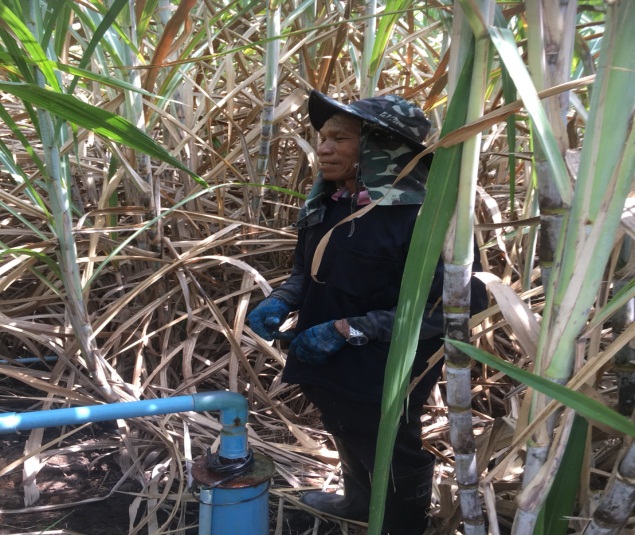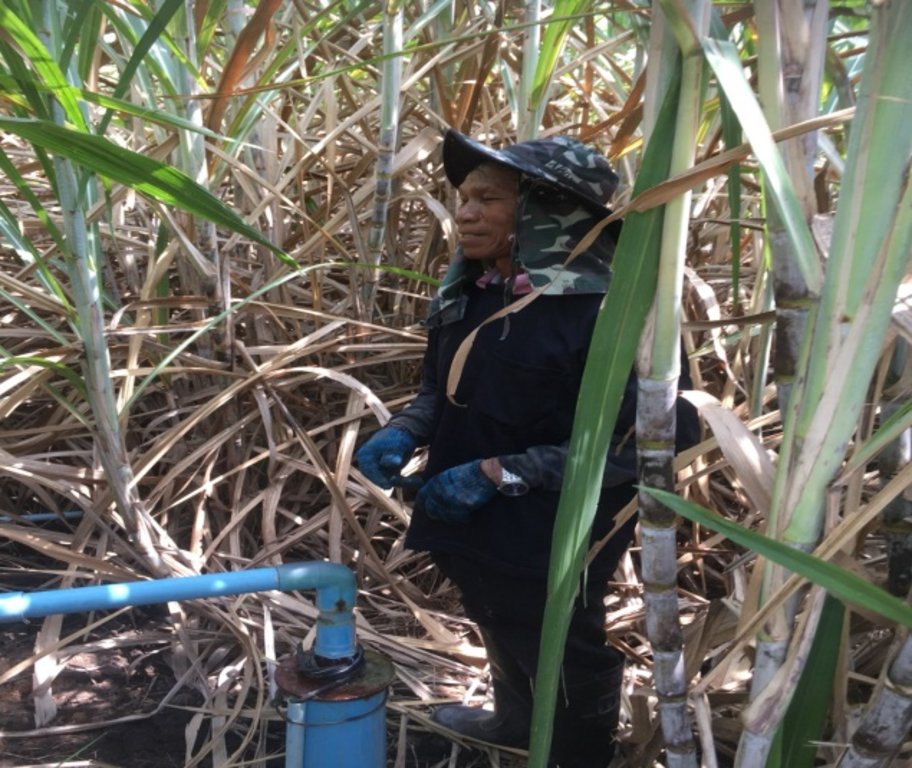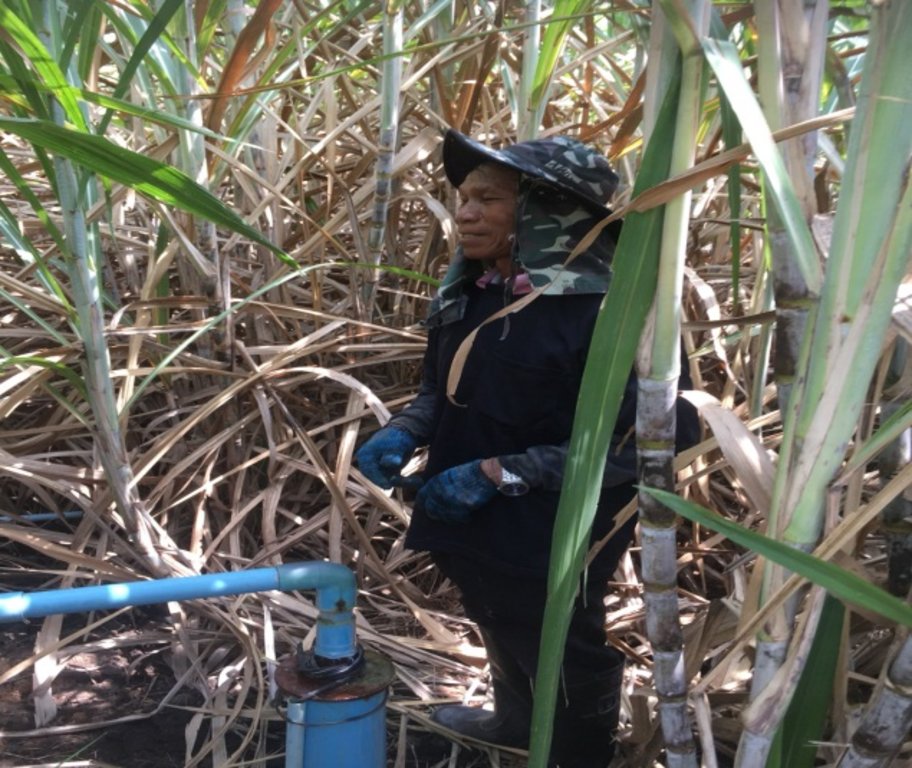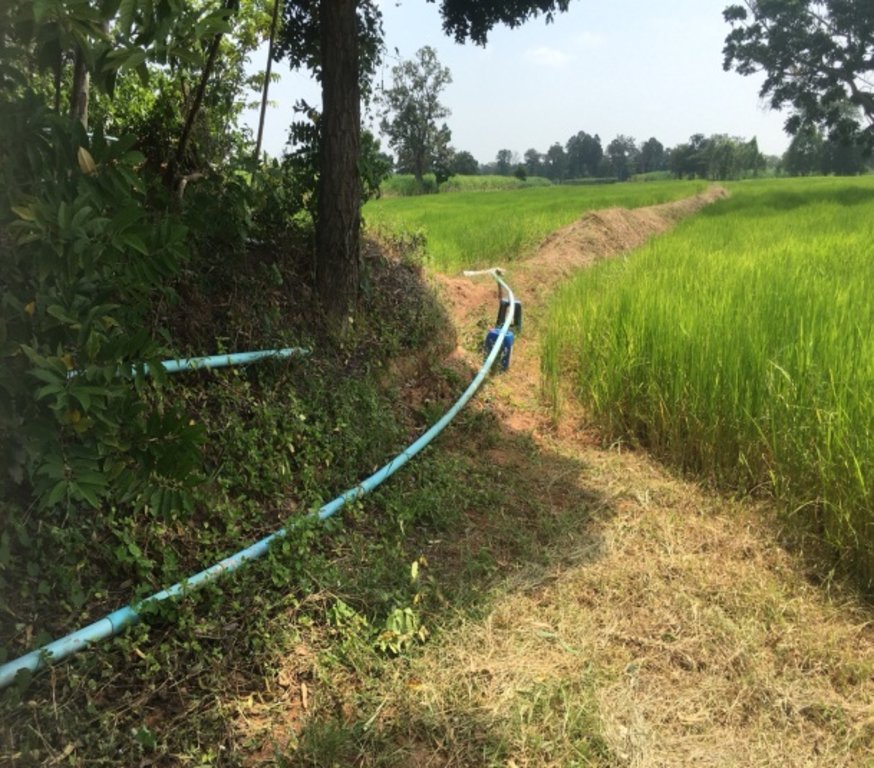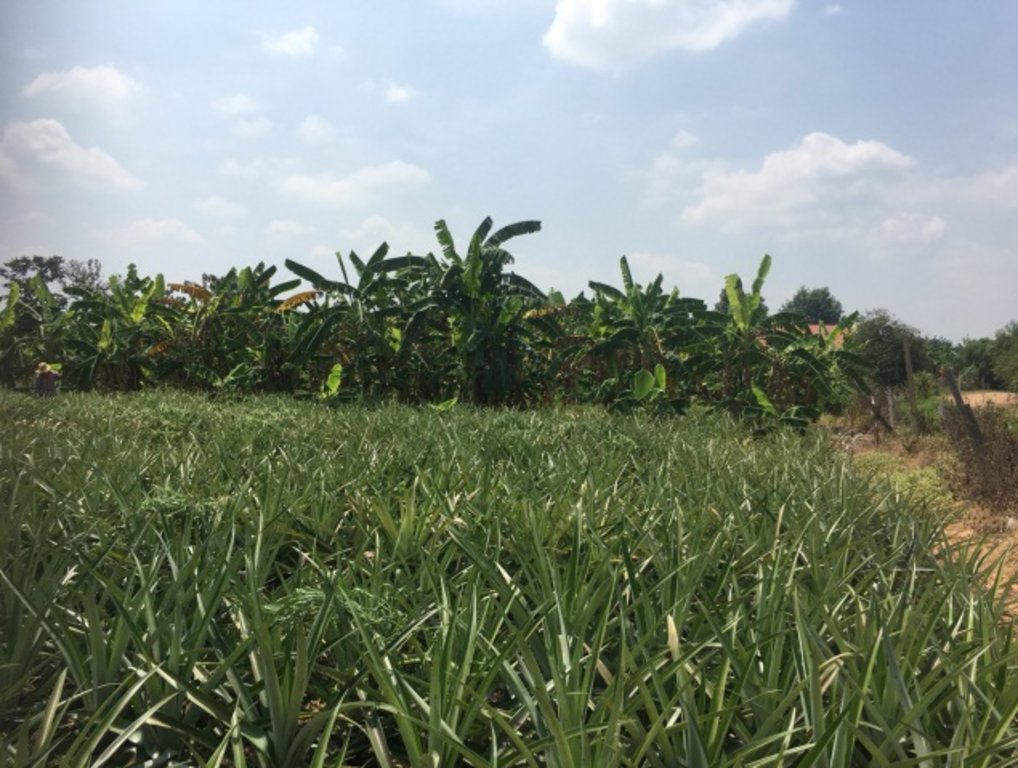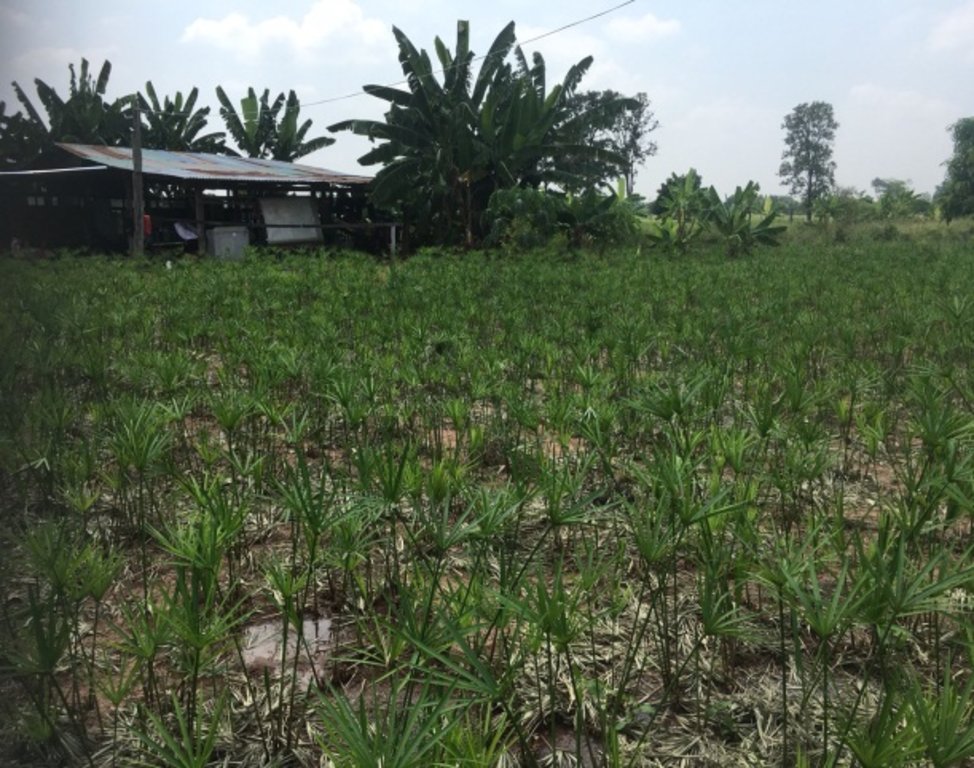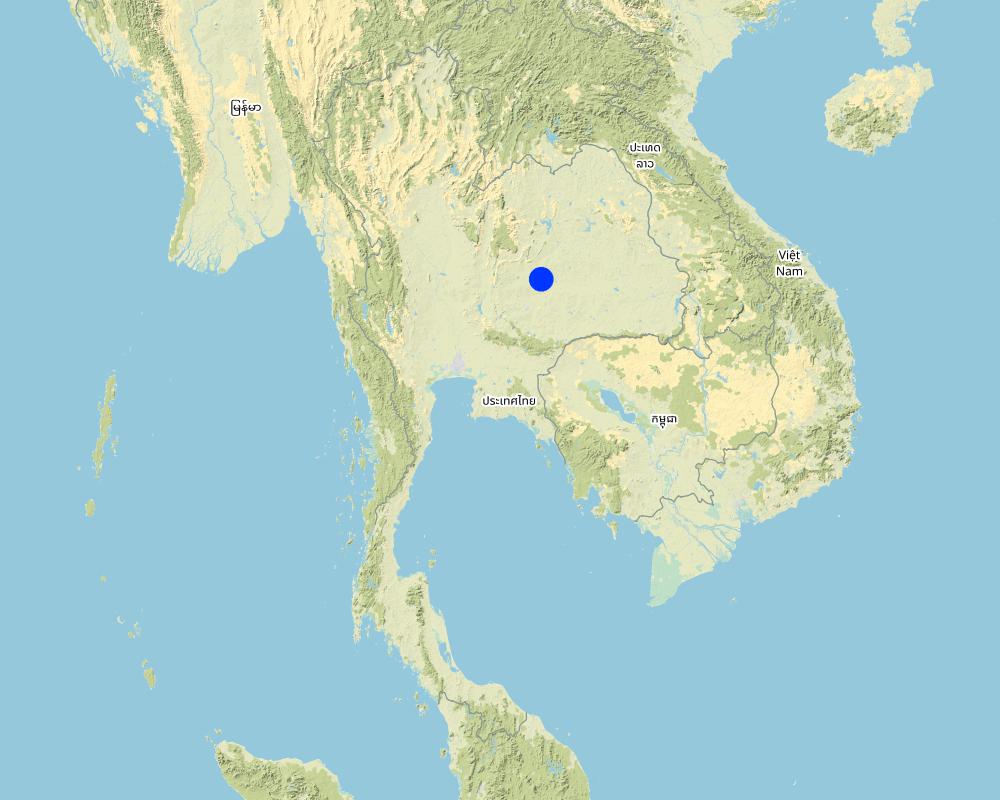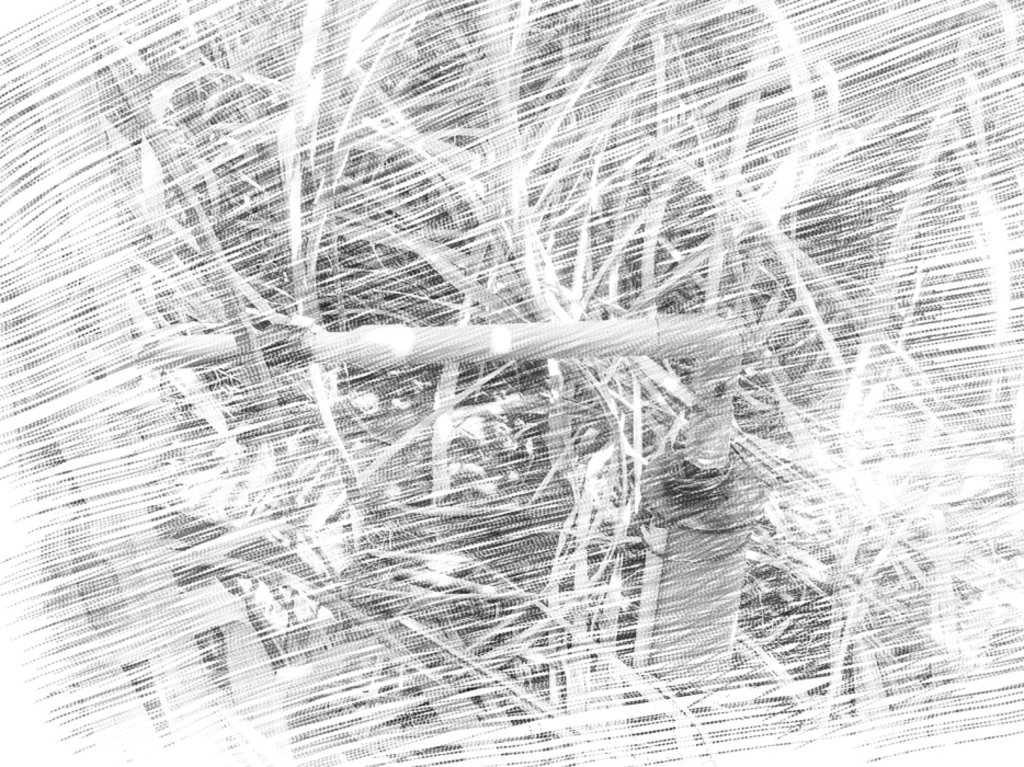Using shallow wells for crops and lowering the saline groundwater table [Thaïlande]
- Création :
- Mise à jour :
- Compilateur : Kaewjai Oechaiyaphum
- Rédacteur : –
- Examinateurs : William Critchley, Pitayakon Limtong, Rima Mekdaschi Studer, Samran Sombatpanit, Joana Eichenberger
shallow well
technologies_4391 - Thaïlande
Voir les sections
Développer tout Réduire tout1. Informations générales
1.2 Coordonnées des personnes-ressources et des institutions impliquées dans l'évaluation et la documentation de la Technologie
Personne(s)-ressource(s) clé(s)
exploitant des terres:
SooPho Boonchu
Land user
Thaïlande
co-compiler:
Spécialiste GDT:
Spécialiste GDT:
Spécialiste GDT:
Spécialiste GDT:
Spécialiste GDT:
Prawanna Prasit
Technical for Land Development Group , Land Development Regional Office 3 , Land Development Department.
Thaïlande
National consultant:
Nom du projet qui a facilité la documentation/ l'évaluation de la Technologie (si pertinent)
Decision Support for Mainstreaming and Scaling out Sustainable Land Management (GEF-FAO / DS-SLM)Nom du projet qui a facilité la documentation/ l'évaluation de la Technologie (si pertinent)
Book project: where the land is greener - Case Studies and Analysis of Soil and Water Conservation Initiatives Worldwide (where the land is greener)Nom du ou des institutions qui ont facilité la documentation/ l'évaluation de la Technologie (si pertinent)
Land Development Department (Land Development Department) - Thaïlande1.3 Conditions relatives à l'utilisation par WOCAT des données documentées
Le compilateur et la(les) personne(s) ressource(s) acceptent les conditions relatives à l'utilisation par WOCAT des données documentées:
Oui
1.4 Déclaration sur la durabilité de la Technologie décrite
Est-ce que la Technologie décrite ici pose problème par rapport à la dégradation des terres, de telle sorte qu'elle ne peut pas être déclarée comme étant une technologie de gestion durable des terres?
Non
Commentaires:
Through this technology, farmers can pump water from shallow wells for agriculture throughout the year: it can lower the groundwater table and reduce salinity. This technology has resulted in reduction salinity in surrounding low land areas. Hence, shallow wells have been accepted by land users.
2. Description de la Technologie de GDT
2.1 Courte description de la Technologie
Définition de la Technologie:
Pumping groundwater from shallow wells for agriculture can control the groundwater table in recharge areas. It helps to manage saline aquifers and reduce soil salinity. Such shallow wells range from 25 to 30 meters deep. This technology is very well-accepted by the land users.
2.2 Description détaillée de la Technologie
Description:
The shallow well is a structure created in the ground by digging or drilling to access water resources. This example of shallow wells is their use in recharge areas to lower groundwater tables. The technology is a subproject of a larger LDD initiative. The technology has been promoted by the Land Development Department at Bua Yai district Nakhon Ratchasima province since 2014. The objectives of the main project are (1) to provide water resources in recharge areas for agriculture: (2) to reduce the amount of saline groundwater and (3) to set up positive economic impact measures.
The process of technology establishment comprises 1) a recharge area survey in salt-affected areas, 2) drilling shallow wells to 25-30 meters depth, 3) installing 5.5 hp gasoline pumps and testing water quality, 4) pumping groundwater and distributing it to the cultivated areas.
Shallow well technology has been implemented on the fields of Mr. Boonchu Supho, Ban Nong Mek, Moo 9, T.Dan Chang, A. Buayai, Nakhon Ratchasima Province. Mr. Boonchu Supho has 21 rai (approx. 3.4 hectares), undulating area with a 2-5% slope, situated at approx. 200 meters above sea level, with a tropical climate, and soil which is classified as being in the series of Kula Ronghai (Ki). This area is upland, and located in the recharge area. Mr. Boonchu Supho has 13 rai (approx. 2 hectares) of lowland rice fields and one shallow well.
In the past, water scarcity was the main issue with his land. Droughts resulted in water scarcity and low productivity. After excavating a shallow well in 2014, groundwater was used for 19 rai of cultivation. Due to soil salinity reduction, rice yields increased to 590 kg/rai (approx. 3700 kg/ha: an increase of approx. 47.4%). Sugar cane yield increased to 30 ton/rai. Moreover, land users can use land more efficiently with mixed plantations of banana, pineapples, sweet bamboo, chilies, galangal and lemongrass to generate income. Even with a drought in 2018, his land had enough water for cultivation, while rice fields in the surrounding area faced water scarcity problem.
In conclusion, the benefits of the shallow well are 1) lowering the groundwater table and reducing salinity, 2) enhancing rice and sugar cane yields, 3) ability to cultivate throughout the year and 4) better soil properties and a better environment. However, the disadvantage of the shallow well is that farmers have to pay for electricity (around 1,200 THB/ 9 months or 10,800 THB/year).
2.3 Photos de la Technologie
Remarques générales concernant les photos:
Using shallow well for planting in the recharge area
2.4 Vidéos de la Technologie
Commentaire, brève description:
To interview Mr. Boonchu Supho
Date:
09/10/2017
Lieu:
Ban Koksa-ard Moo 9 T.Danchanget, A.Buayai, Nakhon-Ratchasima
Nom du vidéaste:
.Jilayus Sommutram
2.5 Pays/ région/ lieux où la Technologie a été appliquée et qui sont couverts par cette évaluation
Pays:
Thaïlande
Région/ Etat/ Province:
Nakhon Ratchasima
Autres spécifications du lieu:
Ban Koksa-ard Moo 10 T.Danchang, A.Buayai
Commentaires:
Mr. Boonchu Supho has in total 21 rai, divided into 1) Recharge area, which is located in the upland zone. Land utilization comprises 2 rai of residence and shallow well, 1.5 rai of the sugar cane field, 1 rai of a banana field, 1 rai of sweet bamboo, 1 rai of pineapple and 0.5 rai of chillies, galangal, and lemongrass. 2) Discharge area, which is located in a low land area. This area has 13 rai of in-season rice
Map
×2.6 Date de mise en œuvre de la Technologie
Indiquez l'année de mise en œuvre:
2014
Si l'année précise est inconnue, indiquez la date approximative: :
- il y a moins de 10 ans (récemment)
2.7 Introduction de la Technologie
Spécifiez comment la Technologie a été introduite: :
- par le biais de projets/ d'interventions extérieures
Commentaires (type de projet, etc.) :
The Land Development Department and local authorities created a demonstration plot to solve the saline soil problem under the LDD project (on preventing soil salinity and to lower the groundwater table in the recharge area) in Bua Yai district. Nakhon Ratchasima Province, since 2014
3. Classification de la Technologie de GDT
3.1 Principal(aux) objectif(s) de la Technologie
- améliorer la production
- réduire, prévenir, restaurer les terres dégradées
- créer un impact économique positif
- prevents soil salinity and to lower the groundwater table on recharge area
3.2 Type(s) actuel(s) d'utilisation des terres, là où la Technologie est appliquée
Les divers types d'utilisation des terres au sein du même unité de terrain: :
Non

Terres cultivées
- Cultures annuelles
- Cultures pérennes (non ligneuses)
- vegetable
Cultures annuelles - Précisez les cultures:
- céréales - riz (de terres humides)
- légumes - autres
Cultures pérennes (non ligneuses) - Précisez les cultures:
- bananier/plantain/abaca
- ananas
- canne à sucre
Nombre de période de croissance par an: :
- 2
Précisez:
Land user growing rice 1 time/year, growing sugar cane 2 times/3 years and using of water punping for vegetable growing during rain delay season/ drought situation
Est-ce que les cultures intercalaires sont pratiquées?
Non
Est-ce que la rotation des cultures est appliquée?
Non

Voies d'eau, plans d'eau, zones humides
Principaux produits/ services:
shallow well
Commentaires:
An excavating shallow well on recharge area was to lower groundwater table and prevent soil salinity in recharge area. Groundwater was used for rice, sugar cane, banana, pineapple and vegetable growing. This technology has increased productivity up to 47.4% in rice: sugar cane has more than doubled its yields.
3.3 Est-ce que l’utilisation des terres a changé en raison de la mise en œuvre de la Technologie ?
Est-ce que l’utilisation des terres a changé en raison de la mise en œuvre de la Technologie ?
- Oui (Veuillez remplir les questions ci-après au regard de l’utilisation des terres avant la mise en œuvre de la Technologie)
Les divers types d'utilisation des terres au sein du même unité de terrain: :
Non

Terres cultivées
- Cultures annuelles
- Cultures pérennes (non ligneuses)
- vegetable
Cultures annuelles - Précisez les cultures:
- céréales - riz (de terres humides)
- légumes - autres
Cultures pérennes (non ligneuses) - Précisez les cultures:
- ananas
- canne à sucre
- sweet bamboo
Est-ce que les cultures intercalaires sont pratiquées?
Non
Est-ce que la rotation des cultures est appliquée?
Non
Commentaires:
An excavated shallow well in the recharge area was to lower groundwater table and prevents soil salinity in the recharge area. Groundwater was used for rice, sugar cane, banana, pineapple, and vegetable growing. This technology has increased productivity up to 47.4% in rice: sugar cane has more than doubled its yields.
3.4 Approvisionnement en eau
autre (par ex., post-inondation):
- shallow well
Commentaires:
Land users know how drought or rain can delay affect productivity. Hence, land users have decided to engage in this project
3.5 Groupe de GDT auquel appartient la Technologie
- système de rotation (rotation des cultures, jachères, agriculture itinérante)
- gestion des eaux souterraines
- desalination
3.6 Mesures de GDT constituant la Technologie

pratiques agronomiques
- A1: Couverture végétale/ du sol
- A2: Matière organique/ fertilité du sol

structures physiques
- S11: Autres
Commentaires:
Groundwater from the shallow well was used for 19 rai of plantation area. The result shows that this technology can increase soil moisture; make a better environment, crop residue from post-harvest can enhance soil organic matter and soil fertility
3.7 Principaux types de dégradation des terres traités par la Technologie

dégradation chimique des sols
- Cs: salinisation/ alcalinisation

dégradation physique des sols
- Pc: compaction
- Pk: scellage et encroûtement

dégradation biologique
- Bc: réduction de la couverture végétale
- Bq: baisse de la quantité/ biomasse
- Bl: perte de la vie des sols

dégradation hydrique
- Hq: baisse de la qualité des eaux souterraines
Commentaires:
There is not much organic fertilizing in 19 rai of land. Most organic fertilizer has been used in vegetable growing while other plantations are usually chemical fertilizing. Hence, increasing crop production needs more chemical fertilizing.
3.8 Prévention, réduction de la dégradation ou réhabilitation des terres dégradées
Spécifiez l'objectif de la Technologie au regard de la dégradation des terres:
- réduire la dégradation des terres
- s'adapter à la dégradation des terres
Commentaires:
The land user has used shallow well technology during drought and rain delay situation since 2014-2018. They found that using shallow wells can reduce groundwater table which might dissolve saline aquifer and spread salinity. Hence, shallow well technology can reduce salinity in lower lying land. With less salt in the topsoil, rice yield has increased to 5-10%
4. Spécifications techniques, activités, intrants et coûts de mise en œuvre
4.1 Dessin technique de la Technologie
4.2 Informations générales sur le calcul des intrants et des coûts
Spécifiez la manière dont les coûts et les intrants ont été calculés:
- par superficie de la Technologie
Indiquez la taille et l'unité de surface:
21 rai own by one selected land user....(e.g. 24 acres, 4.5 hectares)
Si vous utilisez une unité de superficie locale, indiquez le facteur de conversion vers un hectare (p.ex. 1 ha = 2.47 acres): 1 ha = :
1 hectare =…6.25 rai
autre/ monnaie nationale (précisez):
THB
Indiquez le coût salarial moyen de la main d'œuvre par jour:
300 THB
4.3 Activités de mise en place/ d'établissement
| Activité | Calendrier des activités (saisonnier) | |
|---|---|---|
| 1. | To drilling shallow well with 25-30 meters depth | January 2014 |
| 2. | Sugar fields | May 2014, 2016, 2018 |
| 3. | Pineapple fields | May 2018 |
| 4. | Banana fields | May 2014 |
| 5. | Reed fields | May 2015 |
| 6. | Sweet bamboo fields | May 2015 |
| 7. | Chillies, galangal and lemon grass fields | May 2014-2018 |
| 8. | Rice fields | June 2014-2018 |
Commentaires:
No irrigation water therefore planting time depends directly upon the period of the early rainy season, which will be May to July
4.4 Coûts et intrants nécessaires à la mise en place
| Spécifiez les intrants | Unité | Quantité | Coûts par unité | Coût total par intrant | % du coût supporté par les exploitants des terres | |
|---|---|---|---|---|---|---|
| Main d'œuvre | Costs of labor for sugarcane cultivation | puddle | 1,0 | 2500,0 | 2500,0 | |
| Main d'œuvre | Costs of labor for rice cultivation. | rai | 13,0 | 1150,0 | 14950,0 | |
| Main d'œuvre | Costs of labor for sugar cane cultivation. | rai | 1,5 | 1200,0 | 1800,0 | |
| Main d'œuvre | Costs of labor for pineapple cultivation. | rai | 1,0 | 1200,0 | 1200,0 | |
| Equipements | Costs of labor for Banana cultivation | rai | 1,0 | 600,0 | 600,0 | |
| Equipements | Costs of labor for Papyrus cultivation. | rai | 0,5 | 900,0 | 450,0 | |
| Equipements | Costs of labor for Sweet bamboo cultivation. | rai | 1,0 | 600,0 | 600,0 | |
| Equipements | Costs of labor for Chilli, galangal, lemon grass cultivation | rai | 1,0 | 900,0 | 900,0 | |
| Equipements | Cost of shallow water well drilling equipment | puddle | 1,0 | 100000,0 | 100000,0 | |
| Matériel végétal | Bud seedling sugarcane | seedling | 2250,0 | 0,9 | 2025,0 | |
| Matériel végétal | Bud seedling Pineapple | seedling | 2500,0 | 2,0 | 5000,0 | |
| Matériel végétal | Bud seedling Banana | seedling | 100,0 | 10,0 | 1000,0 | |
| Matériel végétal | Bud seedling Papyrus | seedling | 3000,0 | 0,2 | 600,0 | |
| Engrais et biocides | Bud seedling sweet bamboo | seedling | 25,0 | 80,0 | 2000,0 | |
| Engrais et biocides | Bud seedling Chilli, galangal, lemon grass | seedling | 2000,0 | 1,0 | 2000,0 | |
| Engrais et biocides | Seedling rice KDML105 | seedling | 65,0 | 25,0 | 1625,0 | |
| Engrais et biocides | Chemical fertilizer 15-15-15 | kg | 300,0 | 13,0 | 3900,0 | |
| Engrais et biocides | Chicken manure | kg | 2000,0 | 2,0 | 4000,0 | |
| Autre | Electricity charge | hr | 240,0 | 5,0 | 1200,0 | |
| Autre | Machinery | rai | 19,0 | 500,0 | 9500,0 | |
| Coût total de mise en place de la Technologie | 155850,0 | |||||
| Coût total de mise en place de la Technologie en dollars américains (USD) | 155850,0 | |||||
Si le coût n'est pas pris en charge à 100% par l'exploitant des terres, indiquez qui a financé le coût restant:
The Land Development Department supports expenses for drilling shallow wells approximately 100,000 THB. The land users are involved in the maintenance of shallow wells at the 2nd year about 2,000 THB and pay for cost of maintenance and electricity bills about 1,200 baht per month for 9 months. Moreover, land users have to paid for farm pond construction under farm pond project of LDD about 2,500 THB.
Commentaires:
Nong Mek Village, Moo 9, Dan Chang Subdistrict, Bua Yai District, Nakhon Ratchasima Province located on the recharge area which has totally 1,000 rai. Recharge area is a type of upland where use for cassava and sugar cane planting. Most land users have not much knowledge and motivation on shallow well drilling. Hence, Land Development Department comes to train, solution on salt-affected soil with the project on prevents soil salinity, and to lower the groundwater table on recharge area since 2014. The shallow well technology has been implemented through the demonstration plot, which is the first learning center of salt-affected soil management on the recharge area
4.5 Activités d'entretien/ récurrentes
| Activité | Calendrier/ fréquence | |
|---|---|---|
| 1. | Maintenance | 1 Times/year |
| 2. | Electricity charge | 1 Times/month |
Commentaires:
Shallow well which supported by LDD is a type of 5.5 hp gasoline pump then, land users try to use the electric water pump instead. The use of electrical water pump can increases yield productivity and enhance land users’ income. This is resulting in a better life.
4.6 Coûts et intrants nécessaires aux activités d'entretien/ récurrentes (par an)
| Spécifiez les intrants | Unité | Quantité | Coûts par unité | Coût total par intrant | % du coût supporté par les exploitants des terres | |
|---|---|---|---|---|---|---|
| Equipements | electricity charge,5 baht per unit 8 hours per day, 360 days / year | time | 2880,0 | 5,0 | 14400,0 | |
| Equipements | Machinery | time | 1,0 | 2000,0 | 2000,0 | |
| Coût total d'entretien de la Technologie | 16400,0 | |||||
| Coût total d'entretien de la Technologie en dollars américains (USD) | 16400,0 | |||||
Commentaires:
Land users do maintenance this technology by themselves, without hiring labor. There has only cost of modifying.
4.7 Facteurs les plus importants affectant les coûts
Décrivez les facteurs les plus importants affectant les coûts :
Cost of shallow wells implementation at the 1st year consists of 100,000 THB of labor hiring, equipment, and installation. Besides, land users have to pay 2,500 THB for farm pond construction
The expenditure at the 1st year in 2014, pumping groundwater needs to use electricity 8 hours/ 270 day. The amount of water pumping has distributed to 13 rai of rice fields, 1.5 rai of sugar cane fields, 1 rai of chilies, galangal and lemongrass fields. The expenditure at the 1st year with 19 rai is 42,050 THB combine with electricity charge 10,800 THB. Thus, the grand total of expenditure is 52,850 THB.
The income from crop production at 1st year, land users sold rice yield and got 109,200 THB (the average amount of yield is 560 kg/rai, totally gain yield is 7,280 kg, price of rice yield is 15 THB/kg). Land users got 40,500 THB from sugar cane production (the average amount of yield is 30 ton/rai, totally gain yield is 45 ton, price of sugar cane yield is 900 THB/ton). Moreover, land users also got 2,000 THB/month or 24,000 THB/year from chilies, galangal, and lemongrass production. Thus, the grand total of income is 173,700 THB and net income is 120,850 THB
Cost and income at 2nd year in 2015 are described as following;
The expenditure at 2nd year in 2015, pumping groundwater needs to use electricity 8 hours/ 270 day. The amount of water pumping has distributed to 13 rai of rice fields, 1.5 rai of sugar cane fields, 1 rai of sweet bamboo, 1 rai of chilies, galangal and lemongrass fields and 0.5 rai of reed fields. The expenditure at the 2nd year is 40,475 THB combine with electricity charge 10,800 THB and 2,000 THB of water pump modifying fee Thus, the grand total of expenditure is 51,275 THB.
The income from crop production at the 2nd year, land users sold rice yield and got 109,200 THB (the average amount of yield is 560 kg/rai, totally gain yield is 7,280 kg, price of rice yield is 15 THB/kg). Land users got 40,500 THB from sugar cane production (the average amount of yield is 30 ton/rai, totally gain yield is 45 ton, price of sugar cane yield is 900 THB/ton). Moreover, land users also got 3,500 THB/month or 42,000 THB/year from reed, sweet bamboo, chilies, galanga, and lemongrass production. Thus, the grand total of income is 191,700 THB and net income is 140,425 THB
The expenditure at the 3rd year in 2016, pumping groundwater needs to use electricity 8 hours/ 270 day. The amount of water pumping has distributed to 13 rai of rice fields, 1.5 rai of sugar cane fields, 1 rai of sweet bamboo, 1 rai of chilies, galangal and lemongrass fields and 1 rai of reed fields and 0.5 rai of reed. The expenditure at the 3rd year is 40,800 THB combine with electricity charge 10,800 THB and 2,000 THB of water pump modifying fee Thus, the grand total of expenditure is 51,600 THB.
The income from crop production at 3rd year, land users sold rice yield and got 109,200 THB (the average amount of yield is 560 kg/rai, totally gain yield is 7,280 kg, price of rice yield is 15 THB/kg). Land users got 40,500 THB from sugar cane production (the average amount of yield is 30 ton/rai, totally gain yield is 45 ton, price of sugar cane yield is 900 THB/ton). Moreover, land users also got 3,500 THB/month or 42,000 THB/year from reed, sweet bamboo, chilies, galangal, and lemongrass production. Thus, the grand total of income is 191,700 THB and net income is 140,100 THB
The expenditure at the 4th year in 2017, pumping groundwater needs to use electricity 8 hours/ 270 day. The amount of water pumping has distributed to 13 rai of rice fields, 1.5 rai of sugar cane fields, 1 rai of sweet bamboo, 1 rai of chilies, galangal and lemongrass fields and 1 rai of reed fields and 0.5 rai of reed. The expenditure at the 4th year is 37,125 THB combine with electricity charge 10,800 THB and 2,000 THB of water pump modifying fee Thus, the grand total of expenditure is 47,925 THB.
The income from crop production at 4th year, land users sold rice yield and got 109,200 THB (the average amount of yield is 560 kg/rai, totally gain yield is 7,280 kg, price of rice yield is 15 THB/kg). Land users got 40,500 THB from sugar cane production (the average amount of yield is 30 ton/rai, totally gain yield is 45 ton, price of sugar cane yield is 900 THB/ton). Moreover, land users also got 3,500 THB/month or 42,000 THB/year from reed, sweet bamboo, chilies, galangal, and lemongrass production. Thus, the grand total of income is 191,700 THB and net income is 143,775 THB
The expenditure at the 5th year in 2018, pumping groundwater needs to use electricity 8 hours/ 270 day. The amount of water pumping has distributed to 13 rai of rice fields, 1.5 rai of sugar cane fields, 1 rai of sweet bamboo, 1 rai of banana, 1 rai of chilies, galangal and lemongrass fields,1 rai of reed
5. Environnement naturel et humain
5.1 Climat
Précipitations annuelles
- < 250 mm
- 251-500 mm
- 501-750 mm
- 751-1000 mm
- 1001-1500 mm
- 1501-2000 mm
- 2001-3000 mm
- 3001-4000 mm
- > 4000 mm
Spécifiez la pluviométrie moyenne annuelle (si connue), en mm:
1084,00
Spécifications/ commentaires sur les précipitations:
Average annual rainfall from 2008-2013
Indiquez le nom de la station météorologique de référence considérée:
Meteorological Department
Zone agro-climatique
- semi-aride
Temperatures average 13-39 degrees Celsius, average relative humidity 55-89.%
5.2 Topographie
Pentes moyennes:
- plat (0-2 %)
- faible (3-5%)
- modéré (6-10%)
- onduleux (11-15%)
- vallonné (16-30%)
- raide (31-60%)
- très raide (>60%)
Reliefs:
- plateaux/ plaines
- crêtes
- flancs/ pentes de montagne
- flancs/ pentes de colline
- piémonts/ glacis (bas de pente)
- fonds de vallée/bas-fonds
Zones altitudinales:
- 0-100 m
- 101-500 m
- 501-1000 m
- 1001-1500 m
- 1501-2000 m
- 2001-2500 m
- 2501-3000 m
- 3001-4000 m
- > 4000 m
Indiquez si la Technologie est spécifiquement appliquée dans des:
- non pertinent
Commentaires et précisions supplémentaires sur la topographie:
Geography The Bua Yai district is located in the north of Nakhon Ratchasima. On the Korat Plateau
5.3 Sols
Profondeur moyenne du sol:
- très superficiel (0-20 cm)
- superficiel (21-50 cm)
- modérément profond (51-80 cm)
- profond (81-120 cm)
- très profond (>120 cm)
Texture du sol (de la couche arable):
- moyen (limoneux)
Texture du sol (> 20 cm sous la surface):
- moyen (limoneux)
Matière organique de la couche arable:
- faible (<1%)
Si disponible, joignez une description complète du sol ou précisez les informations disponibles, par ex., type de sol, pH/ acidité du sol, capacité d'échange cationique, azote, salinité, etc.
The surface soil is sandy loam. The bottom soil is sandy loam soil. The pH is between 7.5 - 8.5. Salinity is at a salty level. Have salt stains on the surface throughout the year and have very low P and K.
5.4 Disponibilité et qualité de l'eau
Profondeur estimée de l’eau dans le sol:
< 5 m
Disponibilité de l’eau de surface:
moyenne
Qualité de l’eau (non traitée):
uniquement pour usage agricole (irrigation)
La qualité de l'eau fait référence à:
eaux souterraines
La salinité de l'eau est-elle un problème? :
Oui
Précisez:
Slightly saline
La zone est-elle inondée?
Non
Commentaires et précisions supplémentaires sur la qualité et la quantité d'eau:
saline groundwater
5.5 Biodiversité
Diversité des espèces:
- moyenne
Diversité des habitats:
- moyenne
Commentaires et précisions supplémentaires sur la biodiversité:
Before drilling shallow wells there were very few animals living in this area. After 1 year of shallow well being implemented, there is an increase in food and plant sources, the habitat of living things. To implement the technology resulting in more organisms such as fish, birds, rats, earthworms, and insects
5.6 Caractéristiques des exploitants des terres appliquant la Technologie
Sédentaire ou nomade:
- Sédentaire
Orientation du système de production:
- exploitation mixte (de subsistance/ commerciale)
Revenus hors exploitation:
- 10-50% de tous les revenus
Niveau relatif de richesse:
- riche
Individus ou groupes:
- individu/ ménage
Niveau de mécanisation:
- travail manuel
- mécanisé/ motorisé
Genre:
- hommes
Age des exploitants des terres:
- personnes âgées
Indiquez toute autre caractéristique pertinente des exploitants des terres:
Land users are diligent in their work and patient. They carried out crop rotation throughout the year. The, they get more revenue daily, monthly and yearly.
5.7 Superficie moyenne des terres utilisées par les exploitants des terres appliquant la Technologie
- < 0,5 ha
- 0,5-1 ha
- 1-2 ha
- 2-5 ha
- 5-15 ha
- 15-50 ha
- 50-100 ha
- 100-500 ha
- 500-1 000 ha
- 1 000-10 000 ha
- > 10 000 ha
Cette superficie est-elle considérée comme de petite, moyenne ou grande dimension (en se référant au contexte local)?
- moyenne dimension
Commentaires:
Land users drill a shallow well on the recharge area in order to pump groundwater for planting throughout the year to reduce expenses and increase family income
5.8 Propriété foncière, droits d’utilisation des terres et de l'eau
Propriété foncière:
- individu, avec titre de propriété
Droits d’utilisation des terres:
- individuel
- Rainfed.
Est-ce que les droits d'utilisation des terres sont fondés sur un système juridique traditionnel?
Oui
Commentaires:
Land users can decide to use the land by themselves. They did crop rotation by using water pumped from shallow wells. The Land users could be an example for the other that could be shown by surrounding farmer want to engage in this project.
5.9 Accès aux services et aux infrastructures
santé:
- pauvre
- modéré
- bonne
éducation:
- pauvre
- modéré
- bonne
assistance technique:
- pauvre
- modéré
- bonne
emploi (par ex. hors exploitation):
- pauvre
- modéré
- bonne
marchés:
- pauvre
- modéré
- bonne
énergie:
- pauvre
- modéré
- bonne
routes et transports:
- pauvre
- modéré
- bonne
eau potable et assainissement:
- pauvre
- modéré
- bonne
services financiers:
- pauvre
- modéré
- bonne
6. Impacts et conclusions
6.1 Impacts sur site que la Technologie a montrés
Impacts socio-économiques
Production
production agricole
qualité des cultures
risque d'échec de la production
diversité des produits
surface de production
Disponibilité et qualité de l'eau
disponibilité de l'eau potable
qualité de l'eau potable
disponibilité de l'eau pour l'élevage
Revenus et coûts
dépenses pour les intrants agricoles
revenus agricoles
charge de travail
Impacts socioculturels
sécurité alimentaire/ autosuffisance
situation sanitaire
droits d'utilisation des terres/ de l'eau
opportunités culturelles
possibilités de loisirs
institutions communautaires
institutions nationales
connaissances sur la GDT/ dégradation des terres
apaisement des conflits
situation des groupes socialement et économiquement désavantagés
Impacts écologiques
Cycle de l'eau/ ruissellement
quantité d'eau
qualité de l'eau
récolte/ collecte de l'eau
ruissellement de surface
drainage de l'excès d'eau
nappes phréatiques/ aquifères
évaporation
Sols
humidité du sol
couverture du sol
perte en sol
accumulation de sol
encroûtement/ battance du sol
compaction du sol
cycle/ recharge des éléments nutritifs
salinité
matière organique du sol/ au dessous du sol C
acidité
Biodiversité: végétale, animale
Couverture végétale
biomasse/ au dessus du sol C
diversité végétale
espèces étrangères envahissantes
diversité animale
espèces bénéfiques
diversité des habitats
contrôle des animaux nuisibles/ maladies
Réduction des risques de catastrophe et des risques climatiques
impacts des inondations
glissements de terrains/coulées de débris
impacts de la sécheresse
impacts des cyclones, pluies torrentielles
émissions de carbone et de gaz à effet de serre
risques d'incendies
vitesse du vent
microclimat
6.2 Impacts hors site que la Technologie a montrés
disponibilité de l'eau
flux des cours d'eau fiables et stables en saison sèche
inondations en aval
envasement en aval
pollution des rivières/ nappes phréatiques
capacité tampon/de filtration
sédiments (indésirables) transportés par le vent
dommages sur les champs voisins
dommages sur les infrastructures publiques/ privées
impact des gaz à effet de serre
6.3 Exposition et sensibilité de la Technologie aux changements progressifs et aux évènements extrêmes/catastrophes liés au climat (telles que perçues par les exploitants des terres)
Commentaires:
An opinion of the land user, there are many situations such as rain delay during 2014-2016, drought during December – April 201 and flood in rainy season while rain delay in 2018 can lead to water scarcity problem. However, that situation cannot impact farmland with shallow wells.
6.4 Analyse coûts-bénéfices
Quels sont les bénéfices comparativement aux coûts de mise en place (du point de vue des exploitants des terres)?
Rentabilité à court terme:
positive
Rentabilité à long terme:
très positive
Quels sont les bénéfices comparativement aux coûts d'entretien récurrents (du point de vue des exploitants des terres)?
Rentabilité à court terme:
positive
Rentabilité à long terme:
très positive
Commentaires:
Land users to pay a 2,000 baht machinery as a long-term investment to operate for several years and pay the electric fee for water pumping but land users can have 10,800 THB and the revenue daily, monthly and annually and reduce costs in the household
6.5 Adoption de la Technologie
- 1-10%
De tous ceux qui ont adopté la Technologie, combien d'entre eux l'ont fait spontanément, à savoir sans recevoir aucune incitation matérielle, ou aucune rémunération? :
- 0-10%
Commentaires:
Land user and other farmer have knowledge and understanding on an advantage of shallow well technology implemented. Some of them drill water well by themselves.
6.6 Adaptation
La Technologie a-t-elle été récemment modifiée pour s'adapter à l'évolution des conditions?
Oui
autre (précisez):
changing practice
Spécifiez l'adaptation de la Technologie (conception, matériaux/ espèces, etc.):
Land users have modified water pump machine by use electric pump instead of a gasoline pump
6.7 Points forts/ avantages/ possibilités de la Technologie
| Points forts/ avantages/ possibilités du point de vue de l'exploitant des terres |
|---|
| Reduce soil salinity |
| Save money by bringing rice and vegetables grown into household food. |
| Increase sales revenue, rice, sugarcane, pineapple, Papyrus, banana, lemongrass, galangal, chili, and sweet bamboo. |
| Save money by bringing rice and vegetables grown into household food. |
| Points forts/ avantages/ possibilités du point de vue du compilateur ou d'une autre personne ressource clé |
|---|
| Pumping water from shallow wells for agricultural use, can reduce groundwater table and prevent salinity that is a great measure on land degradation mitigation |
| The land user can have food from plant production from their farms. The land user can reduce household expenses. Left to sell, resulting in a daily, monthly and annual income and make a better life. |
| Biodiversity enhancement, there are many plants and living things such as earthworms, birds, fish, frogs, and insects. This is resulting in a balanced ecosystem. |
6.8 Faiblesses/ inconvénients/ risques de la Technologie et moyens de les surmonter
| Faiblesses/ inconvénients/ risques du point de vue de l’exploitant des terres | Comment peuvent-ils être surmontés? |
|---|---|
| After one year of shallow wells implemented, land users must take care and maintain shallow wells as usual. | Make an agreement on taking care of shallow wells after implemented. |
| To inform LDD when something is wrong |
| Faiblesses/ inconvénients/ risques du point de vue du compilateur ou d'une autre personne ressource clé | Comment peuvent-ils être surmontés? |
|---|---|
| Other land users who are not participating. will not get knowledge about the use of shallow well to reduce the level of underground water. | LDD staff / Land users participating in the project to advise or educate other farmers on how to join the project. |
7. Références et liens
7.1 Méthodes/ sources d'information
- visites de terrain, enquêtes sur le terrain
Visit 1 farmer/user's land
- interviews/entretiens avec les exploitants des terres
Interview with 1 farmer.
- interviews/ entretiens avec les spécialistes/ experts de GDT
The Land Development Department officers and planners (7)
Quand les données ont-elles été compilées (sur le terrain)?
03/09/2018
Commentaires:
To be clear on the result of the technology implementation there should be soil sampling as well.
7.2 Références des publications disponibles
Titre, auteur, année, ISBN:
Evaluate the project using water from shallow wells to prevent. Distribution of saline soil as farmers participate in Bua Yai District,Nakhon Ratchasima Province (Kamolthip Sasithorn: 2017
Disponible à partir d'où? Coût?
http://www.ldd.go.th
Titre, auteur, année, ISBN:
Study of groundwater level changes to rice production in an integrated saline soil development project area, Bua Yai District, Nakhon Ratchasima Province (Bowon Buakhao: 2017)
Disponible à partir d'où? Coût?
http://www.ldd.go.th
7.3 Liens vers les informations pertinentes en ligne
Titre/ description:
where the land is greener - Case Studies and Analysis of Soil and Water Conservation Initiatives Worldwide
URL:
https://www.wocat.net/library/media/27/
7.4 Observations d'ordre général
Some part of the questionnaire is very complex such as the cost of input
Liens et modules
Développer tout Réduire toutLiens
Aucun lien
Modules
Aucun module trouvé


